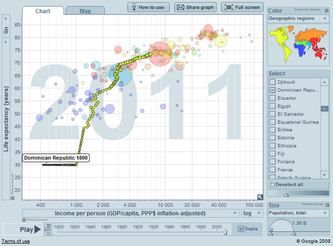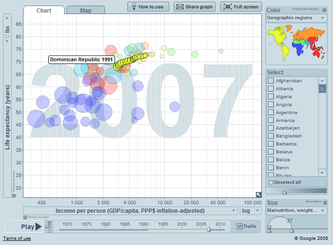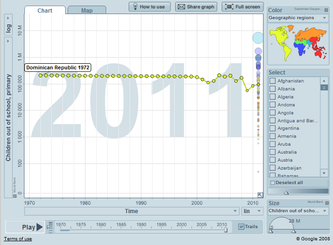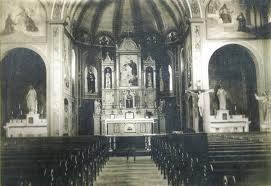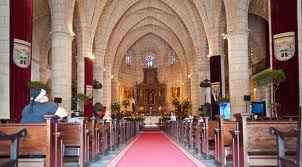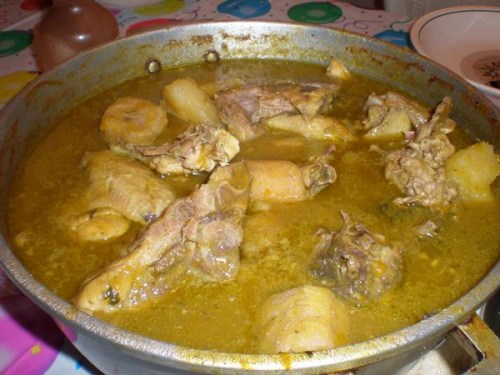Culture and Social Development
Economic Culture
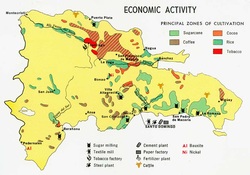
Economic Distribution
www.mapcruzin.com
This map is a demonstration of how economic culture plays a role in the way goods are produced and distributed. According to the Culture Universal Model there are five main themes for culture. They are Religion, Social Aspects, Politics, Aesthetics, and Economics. Economic distribution is demonstrated in this map by the disbursement of product production. Products such as sugarcane, tobacco, and coffee are leading sources for the country's income.
Changes over Time
Below are three images of changes that have occurred in the Dominican Republic. the first change is in population. Over the past few decades population has increased and it is reasonable to predict that population will continue to grow throughout the twenty- first century. Another change is life expectancy, which is also increasing. The second image reflects changes in health, more specifically malnutrition pertaining to underweight children. The amount of underweight children in the Dominican Republic is slowly decreasing. The third and final image represents changes in education. In the past, it was common to see high numbers of students who did not attend school but over the years more students have remained in school.
Heritage and Culture
Heritage in the Dominican Republic plays a large role in the cultures of the country. There are Arawak, Spanish, and French traditions instilled in the citizens. The people of the Dominican republic consider themselves to be more Latin American, rather than Caribbean. In addition, the Dominican Republic was the first port of African American slaves (Countries an their cultures 2). Blacks and mulattoes currently make up ninety percent of the population. Due to influences of African Americans, along with the border of Haiti, the country is divided by skin color ("Cultural life" 2013).
As for other forms of culture, such as food, most national dishes in the Dominican contain rice, beans, and stewed meat. They are also known for their fried plantains. As for economy, sugarcane is perhaps the largest source of income for the country as well as rice and bananas or plantains. As for class and social rank, the Dominican Republic is influenced by race and economics. The upper class consists of Europeans and the lower class mostly consists of African American descendants of the Haitians. One representation of status is education. Middle class people of the country generate enough income to afford a house and car and their children graduate high school. Many young adults who are middle class are even presented with the opportunity to attend college.
Roles are also a large contribution to culture in the Dominican Republic. For example there are the roles of women. Approximately one quarter of lower class people are unemployed (Countries and their cultures 7). Even under these circumstances women tend to find work more easily than men. Many works as seamstresses or in production factories. Though women have more job opportunities, they are always paid less than men. As for families living in middle class, the man is always the main bread winner and therefore dominates the household. The role of a middle class woman has been to remain at home and take care of the children. Yet in modern times, women have attained better control of how many children they have and have more opportunities to educate themselves and find employment.
As for other forms of culture, such as food, most national dishes in the Dominican contain rice, beans, and stewed meat. They are also known for their fried plantains. As for economy, sugarcane is perhaps the largest source of income for the country as well as rice and bananas or plantains. As for class and social rank, the Dominican Republic is influenced by race and economics. The upper class consists of Europeans and the lower class mostly consists of African American descendants of the Haitians. One representation of status is education. Middle class people of the country generate enough income to afford a house and car and their children graduate high school. Many young adults who are middle class are even presented with the opportunity to attend college.
Roles are also a large contribution to culture in the Dominican Republic. For example there are the roles of women. Approximately one quarter of lower class people are unemployed (Countries and their cultures 7). Even under these circumstances women tend to find work more easily than men. Many works as seamstresses or in production factories. Though women have more job opportunities, they are always paid less than men. As for families living in middle class, the man is always the main bread winner and therefore dominates the household. The role of a middle class woman has been to remain at home and take care of the children. Yet in modern times, women have attained better control of how many children they have and have more opportunities to educate themselves and find employment.
The Status of Women in the Dominican Republic
The Dominican Republic is home to diverse cultures, professions, agriculture, and most of all people. The role of men is most often seen as providers in the Dominican Republic, and often the contributions of women are not commended. Some of the roles women play includes the role of the mother, the seamstress, the cook, the housemaid, the factory worker, the educated student, and the wife. While gathering information on the fascinating country that is the Dominican Republic, it is essential to address issues women face and their status in the society they live in.
One role women play in the Dominican Republic greatly revolves around human sexuality. However, women are often exploited and sold to be part of the sex industry. The Dominican Republic holds the fourth largest number for human trafficking of women in the world. Women who are trafficked have been interviewed to find out why they believe they live under such circumstances. Many of the women have children to maintain and therefore see the sex industry as a way to make money to support their families. Other women who are often younger claim they are exploited and were at first extremely unwilling to participate in such a trade, but later rely on the money, whether it be to afford luxurious objects or buy houses for their family members (Trafficking 3). The average age of these women ranges between twenty-four and twenty-eight. Sadly, the truth is that there are thousands of women who unwillingly are placed in the sex industry and never escape. Even those who attempt to escape never truly do as they are later drug dependent or have severe financial burdens.
Another large role women play is the role of the wife. For the women who stay home as their men earn a living, a day consists of cooking and maintain the household. Women begin having children at a very young age soon after they marry. Not all couples use correct contraceptive methods in the Dominican Republic and therefore women are often found taking care of several young children at once. Though these circumstances may appear strenuous for women, there are young women who face worse battles as they lured into marriages (Trafficking 7). These women are not only tricked or sold into marriage but are later sold by their husbands as prostitutes. Thus, the role of the woman changes as the woman, the wife, must become the bread winner for her family and obey her husband at all time. Women are treated as property by the men surrounding them.
Moving past issues that sexually oppress women, there are other oppressive factors related to employment. Some women do receive a full education and continue on to colleges and universities. The issue for women who did not have the means to study, and even those who did, is the sheer difficulty of finding employment. In the Dominican Republic the work of women is still seen as inferior when compared to the work men are capable of. Women are undermined and refused the opportunity to prove their productiveness.
Though women face adversity, those who are persistent are leading a great cause to obtain respect (61). It is the women who are intelligent, hopeful, and who persevere that are leading the country with innovation and determination. These women are attempting to reform the system of education and employment in the Dominican Republic. The status of women will be not be overlooked so long as new young minds continue to come together with the necessary skills to make a difference. Change in the status of women will require women who are willing to hold progression meeting and motivational events that will fire other women up and help the cause.
For the women of the Dominican Republic, whether they are students, mothers, wives, seamstresses, cooks, or housemaids the important factor for them to remember is that women are fully capable of all the success in the world regardless of their gender. It is essential to face the issues presented to women as well as their status in society. The women of the Dominican Republic are contributors to its beauty, agriculture, economy, and growth and therefore must be acknowledged for their roles in society.
One role women play in the Dominican Republic greatly revolves around human sexuality. However, women are often exploited and sold to be part of the sex industry. The Dominican Republic holds the fourth largest number for human trafficking of women in the world. Women who are trafficked have been interviewed to find out why they believe they live under such circumstances. Many of the women have children to maintain and therefore see the sex industry as a way to make money to support their families. Other women who are often younger claim they are exploited and were at first extremely unwilling to participate in such a trade, but later rely on the money, whether it be to afford luxurious objects or buy houses for their family members (Trafficking 3). The average age of these women ranges between twenty-four and twenty-eight. Sadly, the truth is that there are thousands of women who unwillingly are placed in the sex industry and never escape. Even those who attempt to escape never truly do as they are later drug dependent or have severe financial burdens.
Another large role women play is the role of the wife. For the women who stay home as their men earn a living, a day consists of cooking and maintain the household. Women begin having children at a very young age soon after they marry. Not all couples use correct contraceptive methods in the Dominican Republic and therefore women are often found taking care of several young children at once. Though these circumstances may appear strenuous for women, there are young women who face worse battles as they lured into marriages (Trafficking 7). These women are not only tricked or sold into marriage but are later sold by their husbands as prostitutes. Thus, the role of the woman changes as the woman, the wife, must become the bread winner for her family and obey her husband at all time. Women are treated as property by the men surrounding them.
Moving past issues that sexually oppress women, there are other oppressive factors related to employment. Some women do receive a full education and continue on to colleges and universities. The issue for women who did not have the means to study, and even those who did, is the sheer difficulty of finding employment. In the Dominican Republic the work of women is still seen as inferior when compared to the work men are capable of. Women are undermined and refused the opportunity to prove their productiveness.
Though women face adversity, those who are persistent are leading a great cause to obtain respect (61). It is the women who are intelligent, hopeful, and who persevere that are leading the country with innovation and determination. These women are attempting to reform the system of education and employment in the Dominican Republic. The status of women will be not be overlooked so long as new young minds continue to come together with the necessary skills to make a difference. Change in the status of women will require women who are willing to hold progression meeting and motivational events that will fire other women up and help the cause.
For the women of the Dominican Republic, whether they are students, mothers, wives, seamstresses, cooks, or housemaids the important factor for them to remember is that women are fully capable of all the success in the world regardless of their gender. It is essential to face the issues presented to women as well as their status in society. The women of the Dominican Republic are contributors to its beauty, agriculture, economy, and growth and therefore must be acknowledged for their roles in society.
Religion in the Dominican Republic
When it comes to the subject of religion, over ninety-five percent of people living
in the Dominican Republic are Roman Catholics. This religion was established by
the Vatican. The Catholic church itself arrived when Christopher Columbus
arrived (Feliz 3). The Founding Fathers of the Dominican Republic were catholic,
and the D.R. was declared a catholic state.
The role of religion in social development has influenced the way of life of the
people. For example, marriages and the process and requirements of couples have
been established, Other factors as well have been established, such as the
baptism of young children. Ceremonies are only recognizable if they follow Roman
Catholic procedures. Also, children in public schools must read the Bible
(Keeping the Faith 2).
Religious places in the Dominican Republic include churches. They are used for worship,
marriages, baptisms, communions, and other religious milestones. In the past
mass amounts of people attended church on a regular basis. In modern times
though people attend, there attendance is rarely regular and religious practices
have decreased.
As for politics related to religion, the Catholic Church has always
played a major role. As stated before, from the beginning, even the Founding
Fathers of the new government system were Catholic. As seen by the state, the
Dominican Republic is a Catholic Nation (Keeping the Faith 4). There is support
from the government for Roman Catholics.
Protestantism is another religion that has blossomed in the Dominican Republic in the past.
Protestantism began flourishing in the 1900’s and was brought about by
immigrants. This religion has become attractive to low status families for
various reasons. Though unexpected, many people are converting from Roman
Catholicism to Evangelical Protestantism.
The role of religion in current social development is one of change. The reason it
attracts low income families is because it emphasizes on the banning of negative
factors in life. This religion is based on family values and condemns such
ailments as alcohol, spouse-beating, prostitution, and abuse within families
(Dominicans 5).
This religion is practiced in churches or in smaller groups led and initiated by
missionaries or believers of the benefits of this religion. Those attracted
include low income families because of the unstable families seen in their
communities. People see this religious belief as an outlet and way to avoid
negativity within their own families Dominicans 6).
Similar to the inclusion of Catholicism in the Dominican Republic, the Dominican
Republic has long struggled with the Vatican over the power of the government in
regards to religion. The Vatican did not wish to grant concessions to a small
country as it once had to the King of Spain. Religion is accepted by the
government, although it is mostly in aid of Catholic religion over any other
(Dominican Concordats 3).
in the Dominican Republic are Roman Catholics. This religion was established by
the Vatican. The Catholic church itself arrived when Christopher Columbus
arrived (Feliz 3). The Founding Fathers of the Dominican Republic were catholic,
and the D.R. was declared a catholic state.
The role of religion in social development has influenced the way of life of the
people. For example, marriages and the process and requirements of couples have
been established, Other factors as well have been established, such as the
baptism of young children. Ceremonies are only recognizable if they follow Roman
Catholic procedures. Also, children in public schools must read the Bible
(Keeping the Faith 2).
Religious places in the Dominican Republic include churches. They are used for worship,
marriages, baptisms, communions, and other religious milestones. In the past
mass amounts of people attended church on a regular basis. In modern times
though people attend, there attendance is rarely regular and religious practices
have decreased.
As for politics related to religion, the Catholic Church has always
played a major role. As stated before, from the beginning, even the Founding
Fathers of the new government system were Catholic. As seen by the state, the
Dominican Republic is a Catholic Nation (Keeping the Faith 4). There is support
from the government for Roman Catholics.
Protestantism is another religion that has blossomed in the Dominican Republic in the past.
Protestantism began flourishing in the 1900’s and was brought about by
immigrants. This religion has become attractive to low status families for
various reasons. Though unexpected, many people are converting from Roman
Catholicism to Evangelical Protestantism.
The role of religion in current social development is one of change. The reason it
attracts low income families is because it emphasizes on the banning of negative
factors in life. This religion is based on family values and condemns such
ailments as alcohol, spouse-beating, prostitution, and abuse within families
(Dominicans 5).
This religion is practiced in churches or in smaller groups led and initiated by
missionaries or believers of the benefits of this religion. Those attracted
include low income families because of the unstable families seen in their
communities. People see this religious belief as an outlet and way to avoid
negativity within their own families Dominicans 6).
Similar to the inclusion of Catholicism in the Dominican Republic, the Dominican
Republic has long struggled with the Vatican over the power of the government in
regards to religion. The Vatican did not wish to grant concessions to a small
country as it once had to the King of Spain. Religion is accepted by the
government, although it is mostly in aid of Catholic religion over any other
(Dominican Concordats 3).
Preserving Cultural Diversity in the Dominican Republic
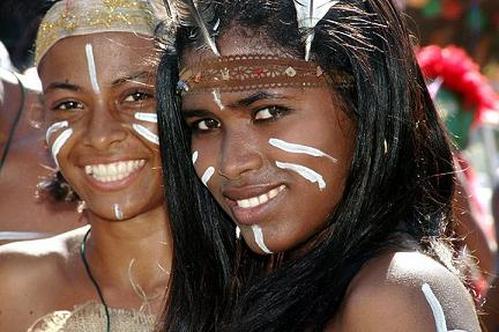
Dominican Republic Cuture travel-dominicanrepublic.com
For many countries, preserving cultural diversity is a difficult goal. Not much is different for the country of the Dominican Republic as they also are faced with challenges in preserving culture. Culture varies from foods that are created using old recipes and local ingredients, to the ways people live, such as the clothes they wear and the resources they use.
Although the Dominican Republic is faced with challenges, there are humanitarians and people who work to preserve the countries diversity. One example of overcoming a struggle has been maintaining traditions under different leadership. In the past dictators have prohibited celebrations of certain holidays or expressing certain religious beliefs. An even larger issue has been rules of hierarchy. People with darker skin or of mixed races are not given the importance of the rich who have lighter skin. Thus, there are certain people who never move out of the lower class, and the elite remain wealthy. The children of the wealthy will age to be wealthy as well and this is due to the government and status the elite are labeled with from birth (don Quijote 1996).
For centuries the upper class have been of European descent and the lower class of African descent.The Dominican Republic is making progress in this issue. The middle class is growing, pulling in both a small section of the lower class and of the upper class. In the near future, those who once descended from the lower class will have similar opportunities as those who once descended from the upper class. This is one of many ways the Dominican Republic will maintain some of its cultural diversity. People of various races and backgrounds will live in the same communities. More children will be born of mixed races and the knowledge of traditions will rise. Within a community, the people of the Dominican republic will share new foods with each other, speak more openly of their religions, and work together to create policies that are respectful of all cultures and beliefs.
Although the Dominican Republic is faced with challenges, there are humanitarians and people who work to preserve the countries diversity. One example of overcoming a struggle has been maintaining traditions under different leadership. In the past dictators have prohibited celebrations of certain holidays or expressing certain religious beliefs. An even larger issue has been rules of hierarchy. People with darker skin or of mixed races are not given the importance of the rich who have lighter skin. Thus, there are certain people who never move out of the lower class, and the elite remain wealthy. The children of the wealthy will age to be wealthy as well and this is due to the government and status the elite are labeled with from birth (don Quijote 1996).
For centuries the upper class have been of European descent and the lower class of African descent.The Dominican Republic is making progress in this issue. The middle class is growing, pulling in both a small section of the lower class and of the upper class. In the near future, those who once descended from the lower class will have similar opportunities as those who once descended from the upper class. This is one of many ways the Dominican Republic will maintain some of its cultural diversity. People of various races and backgrounds will live in the same communities. More children will be born of mixed races and the knowledge of traditions will rise. Within a community, the people of the Dominican republic will share new foods with each other, speak more openly of their religions, and work together to create policies that are respectful of all cultures and beliefs.
Food Culture
In the Dominican Republic, there are unusual foods, tasty foods, an just plain comfort food. When it comes to food culture in the Dominican Republic, traditions and history play a large role. Influences in traditional dishes can be traced back to the Spanish, African, and Taino. Though many Dominican dishes can be found in Latin American culture, they are called different names, mostly because of the various cultural dialects.
As opposed to the united States, the Dominican Republic has less frequent snacking and lighter meals. Lunch is the largest meal of the day as most people only drink coffee and eat bread for breakfast. For lunch, people sit for a heavy meal that will give them the energy they need for the remainder of the day. The lunch of most Dominicans consists of the staple foods, which are rice, beans, rice, and of course meat (Morandi 2012).
If you are feeling hungry by now you can consider trying a full dominican meal. The young people drink fruit smoothies with their meals while the adults enjoy rum or beer. The most popular dish among Dominicans is Sancocho, a stew made with seven different kinds of meat, potatoes, and other vegetables. For desert, and often for special occasions, the most popular desert is a cake called biscocho dominicano. At the end of the day, if anyone is still hungry in the Dominican Republic, they eat a light meal or drink a glass of milk before bed.
As opposed to the united States, the Dominican Republic has less frequent snacking and lighter meals. Lunch is the largest meal of the day as most people only drink coffee and eat bread for breakfast. For lunch, people sit for a heavy meal that will give them the energy they need for the remainder of the day. The lunch of most Dominicans consists of the staple foods, which are rice, beans, rice, and of course meat (Morandi 2012).
If you are feeling hungry by now you can consider trying a full dominican meal. The young people drink fruit smoothies with their meals while the adults enjoy rum or beer. The most popular dish among Dominicans is Sancocho, a stew made with seven different kinds of meat, potatoes, and other vegetables. For desert, and often for special occasions, the most popular desert is a cake called biscocho dominicano. At the end of the day, if anyone is still hungry in the Dominican Republic, they eat a light meal or drink a glass of milk before bed.
Resources
Countries and their cultures. (2013). Retrieved from http://www.everyculture.com/Cr-Ga/Dominican-Republic.html
Cultural life. (2013). Retrieved from http://www.britannica.com/EBchecked/topic/168728/Dominican-Republic/54446/Cultural-life
Hall, Meredith.Women, Employment, and Empowerment in the Dominicahttp://soa.utexas.edu/files/crpla/Bossin_MA_Thesis.pdfn Republic.
Dominicans. Countries and their Cultures. www.everyculture.com
Dominican Concordats. www.concordatwatch.eu
Dominican Republic Society. don Quijote 1996. http://www.donquijote.org/culture/dominican-republic/society/
Feliz, Arturo. The Catholic Church in the History of the Dominican Republic. www.dominicantoday.com
Keeping the Faith. www.dominicanrepublic-guide.info
Morandi, Carlita. Traditions and Culture of the Dominican Republic. Travelor's Press. Sep. 12. 2012.
Trafficking. Factbook on Global Sexual Exploitation http://www.uri.edu/artsci/wms/hughes/domrep.htm
Cultural life. (2013). Retrieved from http://www.britannica.com/EBchecked/topic/168728/Dominican-Republic/54446/Cultural-life
Hall, Meredith.Women, Employment, and Empowerment in the Dominicahttp://soa.utexas.edu/files/crpla/Bossin_MA_Thesis.pdfn Republic.
Dominicans. Countries and their Cultures. www.everyculture.com
Dominican Concordats. www.concordatwatch.eu
Dominican Republic Society. don Quijote 1996. http://www.donquijote.org/culture/dominican-republic/society/
Feliz, Arturo. The Catholic Church in the History of the Dominican Republic. www.dominicantoday.com
Keeping the Faith. www.dominicanrepublic-guide.info
Morandi, Carlita. Traditions and Culture of the Dominican Republic. Travelor's Press. Sep. 12. 2012.
Trafficking. Factbook on Global Sexual Exploitation http://www.uri.edu/artsci/wms/hughes/domrep.htm
